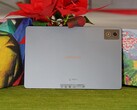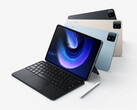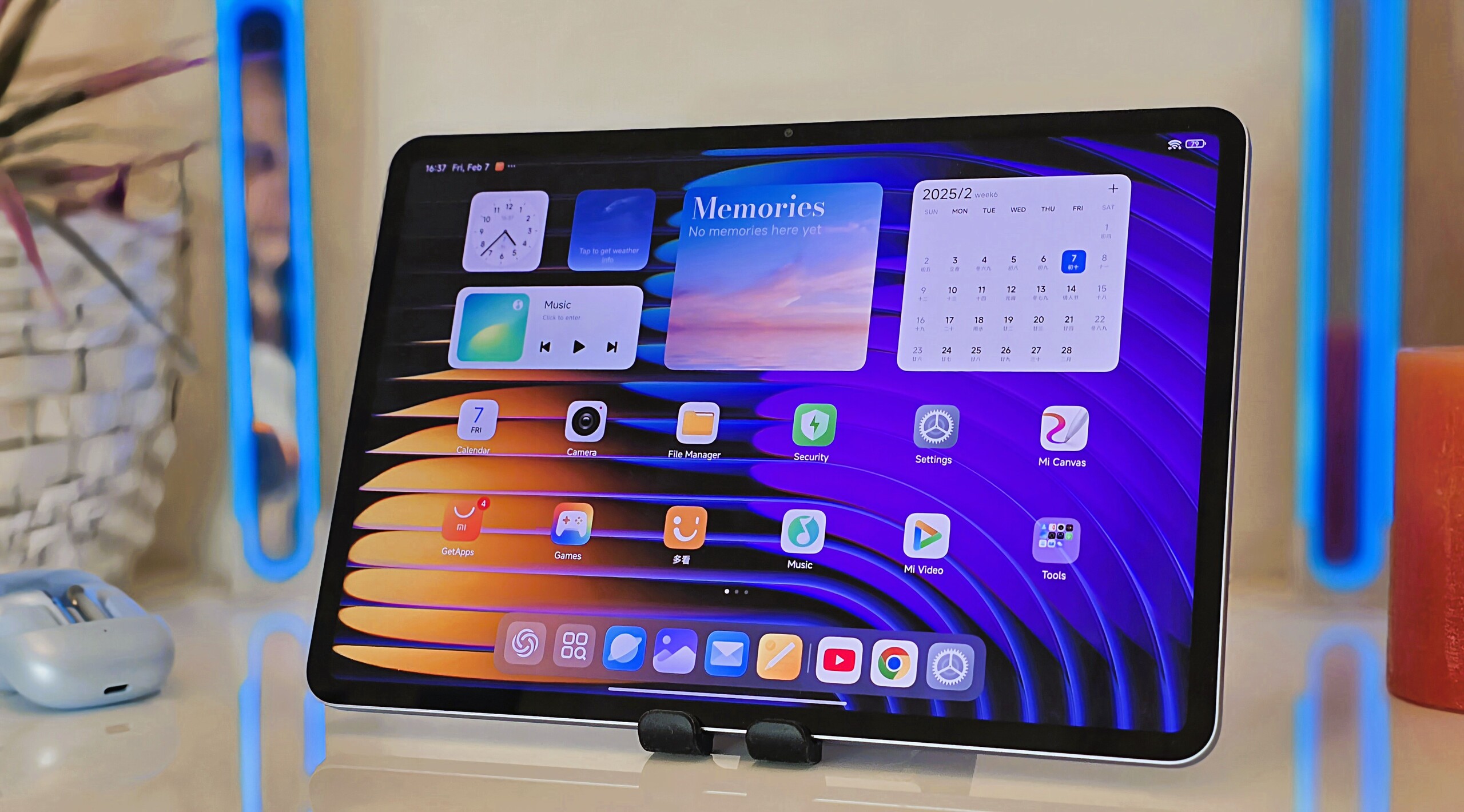
Xiaomi Pad 7 Pro review - An affordable tablet with fantastic staying power and a superb screen
A cheaper alternative to the Apple iPad Air.
In many areas, Xiaomi's Pad 7 Pro is better than an iPad Air 2024 but costs less than half the price. In particular, the Xiaomi Tab's 3K display is unrivaled in this price range. However, compared to the Xiaomi Pad 7, there is probably a catch with the Pro version.Marcus Herbrich, 👁 Daniel Schmidt (translated by Andrew Dickson) Published 🇩🇪 🇷🇺 ...
Xiaomi Pad 7 Pro verdict
In our review, the Xiaomi Pad 7 Pro impressed us with a very favorable performance, feature and price ratio. It comes with a powerful Qualcomm processor, a PWM-free, high-resolution display, and an excellent speaker system that ensures the user enjoys great sound. The result is a mid-range tablet that is ideal for multimedia applications. Thanks to the extremely good battery life, as well as pen support and an optional keyboard case, nothing will stand in your way of getting some productive work done.
However, the Xiaomi tablet also leaves some question marks, especially concerning the update policy and global availability. Users who expect long-term software support should, therefore, opt for either a Galaxy Tab S9 or a Samsung Galaxy Tab S9 FE. In addition, the Pad 7 Pro is somewhat limited in terms of connectivity due to its lack of GNSS and 5G options, as well as the absence of 6 GHz Wi-Fi.
Pros
Cons
Price and availability
The Xiaomi Pad 7 Pro is currently only available as an import in Germany. In China, the mid-range tablet costs 2,499 yuan (approx. $330) in the basic version. At our partner shop Trading Shenzhen, prices start at around $440. There are currently no further indications of a global launch, so the Pro version – similar to the Pad 6 series – will probably not make its way to Europe.
Possible alternatives compared
Image | Model / Review | Price | Weight | Drive | Display |
|---|---|---|---|---|---|
| Xiaomi Pad 7 Pro Qualcomm Snapdragon 8s Gen 3 ⎘ Qualcomm Adreno 735 ⎘ 12 GB Memory, 256 GB | Amazon: 1. $527.50 Xiaomi Pad 7 Pro Ai WiFi Ver... 2. $527.50 Xiaomi Pad 7 Pro Ai WiFi Ver... 3. $477.50 Xiaomi Pad 7 Pro Ai WiFi Ver... List Price: 450€ | 500 g | 256 GB UFS 4.0 Flash | 11.20" 3200x2136 344 PPI IPS | |
| OnePlus Pad 2 Qualcomm Snapdragon 8 Gen 3 ⎘ Qualcomm Adreno 750 ⎘ 12 GB Memory, 256 GB | Amazon: $549.99 List Price: 549€ | 584 g | 256 GB UFS 3.1 Flash | 12.10" 3000x2120 304 PPI IPS | |
| Apple iPad Air 11 2024 Apple M2 ⎘ Apple M2 10-Core GPU ⎘ 8 GB Memory, 128 GB NVMe | Amazon: List Price: 699€ | 462 g | 128 GB NVMe | 10.86" 2360x1640 265 PPI IPS | |
| Huawei MatePad 11.5 S HiSilicon Kirin 9000W ⎘ HiSilicon Maleoon 910 ⎘ 8 GB Memory, 256 GB | Amazon: 1. $28.99 YOUULAR Tablet Case for Huaw... 2. $11.96 Kepuch 2 Pack Tempered Glass... 3. $12.96 Kepuch Custer Case Compatibl... List Price: 399€ | 510 g | 256 GB UFS 3.1 Flash | 11.50" 2800x1840 291 PPI TFT-LCD | |
| Samsung Galaxy Tab S9 5G Qualcomm Snapdragon 8 Gen 2 for Galaxy ⎘ Qualcomm Adreno 740 ⎘ 12 GB Memory, 256 GB | Amazon: List Price: 1169€ | 500 g | 256 GB UFS 4.0 Flash | 11.00" 2560x1600 274 PPI Dynamic AMOLED 2x |
Table of Contents
- Xiaomi Pad 7 Pro verdict
- Xiaomi Pad 7 Pro specifications
- Case - The Xiaomi tablet has a metal chassis
- Features - The Pad 7 Pro uses USB 3.2
- Software - The Xiaomi tab runs Android 15
- Communication and GNSS - A tablet lacking GPS
- Cameras - The Xiaomi tablet has a single camera
- Accessories and warranty - The Pad 7 Pro comes with a power adapter
- Input devices and operation - The Xiaomi tablet and 360 Hz
- Display - The Pad 7 Pro uses LCD
- Performance - The Xiaomi tablet relies on Qualcomm
- Emissions
- Battery runtimes - The Xiaomi tablet charges quickly
- Notebookcheck overall rating
Along with the Xiaomi 15 and the Xiaomi 15 Pro, the Chinese manufacturer presented the Xiaomi Pad 7 Pro as part of its China event. The mid-range tablet features a well-specced 11.2-inch display and a Snapdragon 8s Gen 3. Given the low price, the manufacturer has also made no compromises when it comes to optional accessories. A keyboard cover with illuminated keys and a stylus can also transform the Pad 7 Pro into a work machine for school or university.
Xiaomi Pad 7 Pro specifications
Case - The Xiaomi tablet has a metal chassis
The Pad 7 Pro's fit and finish are very good, and the aluminum frame and rear also have a high-quality feel. Thanks to the matte finish, fingerprints are not a problem, but the manufacturer hasn't specified which protective glass is used on the front.
With a weight of 500 grams and a case thickness of just under 6 millimeters, the Xiaomi tablet is easy to handle even when used for long periods. Despite its 11-inch frame, the Pad 7 Pro has quite compact dimensions. This is also made possible by its good screen-to-body ratio of around 86 percent. This results in quite slim screen bezels. The case does not come with IP certification.
Features - The Pad 7 Pro uses USB 3.2
The Xiaomi tablet comes with either 8 or 12 GB of LDDR5X RAM and 256 or 512 GB of UFS 4.0 storage. In addition, the Pad 7 Pro offers a strong feature set for a mid-range tablet with its quad speaker system, stylus support, Miracast and fingerprint sensor. In our tests, we also measured a very decent data transfer speed of up to 212 MB/s with a Samsung 980 Pro (M2 SSD hard drive) via the fast USB 3.2 port (Gen. 1). The connected storage media can be formatted using NTFS or exFAT. With the help of an adapter, the USB port can also be used to output image signals to external screens.
Software - The Xiaomi tab runs Android 15
The Pad 7 Pro uses the company's own second-generation HyperOS, which includes Play Protect certification. Our Chinese version does not support Google services out of the box, but the Google Frameworks are already preinstalled when delivered. This means that the PlayStore can be installed manually via the company's own app store. However, in addition to Chinese and English, no German language pack can be selected
Xiaomi is reluctant to provide information regarding software updates for the Chinese market. At the time of our review, the Xiaomi tablet had Android 15 and included security patches from December 2024. We would not assume more than two to three years of product support.
Sustainability
Xiaomi has not provided detailed information concerning the materials used and their recycling rate, but the manufacturer has provided general recycling information. The focus is on increasing the use of recycled materials, including aluminum, gold and copper. The use of organic-based high-polymer materials and recycled plastic from discarded fishing nets should also help keep the ecological footprint to a minimum.
The packaging appears to be plastic-free, but the device itself is wrapped in foil. The rest of the packaging is made of cardboard.
Communication and GNSS - A tablet lacking GPS
The Xiaomi tablet offers neither the option of using mobile data nor does it support location via satellite systems
Within a home network, the Pad 7 Pro uses the modern WiFi 7 standard, but only the 2.4 and 5 GHz range is used to establish a connection. In our test paired with the Asus ROG Rapture GT-AXE11000, we achieved impressive transfer speeds of almost 1,000 Mbit/s without the 6 GHz band. However, we were unable to fully exploit WiFi 7 using our 6E reference router.
| Networking | |
| iperf3 transmit AXE11000 | |
| Average Wi-Fi 7 (556 - 1828, n=62) | |
| Huawei MatePad 11.5 S | |
| Xiaomi Pad 7 Pro | |
| Samsung Galaxy Tab S9 5G | |
| Average of class Tablet (10.5 - 1801, n=87, last 2 years) | |
| iperf3 receive AXE11000 | |
| Average Wi-Fi 7 (565 - 1875, n=62) | |
| Samsung Galaxy Tab S9 5G | |
| Xiaomi Pad 7 Pro | |
| Huawei MatePad 11.5 S | |
| Average of class Tablet (20.1 - 1857, n=87, last 2 years) | |
| iperf3 transmit AXE11000 6GHz | |
| Average Wi-Fi 7 (563 - 1945, n=48) | |
| Average of class Tablet (578 - 1898, n=29, last 2 years) | |
| OnePlus Pad 2 | |
| Apple iPad Air 11 2024 | |
| iperf3 receive AXE11000 6GHz | |
| OnePlus Pad 2 | |
| Average Wi-Fi 7 (451 - 1864, n=48) | |
| Average of class Tablet (746 - 1874, n=29, last 2 years) | |
| Apple iPad Air 11 2024 | |
Cameras - The Xiaomi tablet has a single camera
Xiaomi has taken inspiration from its sister model, the Pad 6S Pro, when it comes to the Pad 7 Pro's camera system. The 32 MPix lens on the front uses pixel binning but only works with a fixed focus. The photo quality is still acceptable for this price range. Videos can be recorded using the front camera at 30fps in FullHD quality. On top of this, the mid-range tablet can produce moving images in 4K60.
The heart of the camera system is an autofocus 50 MPix lens and an aperture of f/1.8. In daylight, the Samsung JN1 produces good photos, and for a tablet under $500, they are of excellent quality. However, the color reproduction sometimes seems a bit oversaturated. The quality offered by the Pad 7 Pro is very suitable for taking photos of documents for adding notes at a later date. With the corresponding mode, the recognized document area is also automatically cropped and saved.
Image comparison
Choose a scene and navigate within the first image. One click changes the position on touchscreens. One click on the zoomed-in image opens the original in a new window. The first image shows the scaled photograph of the test device.
Wide-angleWide-angleLow-lightZoom 5x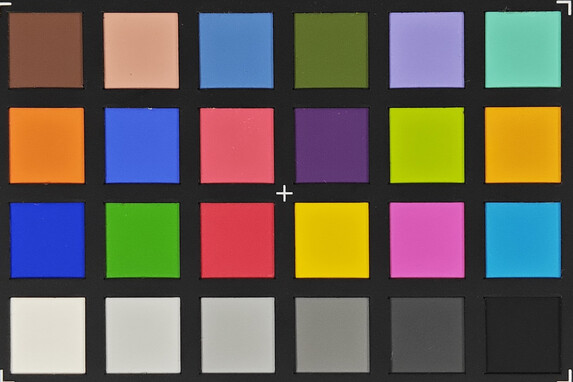

Accessories and warranty - The Pad 7 Pro comes with a power adapter
The box contents include a 67-watt quick-charge power adapter, a data or charging cable (USB-A to USB-C) and a quick guide. Trading Shenzhen expands on the extras included with the Chinese version by adding an EU adapter for the charger and a USB OTG adapter. An optional stylus and a keyboard cover are also available for the Pad 7 Pro.
Our import device comes with a 12-month warranty. In the event of a warranty claim, Trading Shenzhen offers the option of sending the smartphone to a German shipping address.
Input devices and operation - The Xiaomi tablet and 360 Hz
The device can be operated with both your fingers and the 15-gram Xiaomi Focus Pen, which has 8,192 pressure sensitivity levels. Thanks to the high refresh rate of up to 144 Hz, the display is buttery smooth despite the 3K resolution and inputs are implemented without delay with a sampling rate of 360 Hz. However, we were still able to coax the odd micro-stutter from our review device.
A fingerprint sensor is located in the on/off button and can be found on the left-hand side of the tablet. The sensor area is very easy to reach with your index finger. Unlocking works quickly and reliably, and 2D facial recognition via the front camera is also possible.
Display - The Pad 7 Pro uses LCD
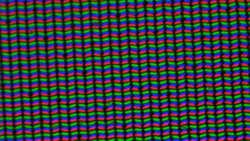
The IPS panel has a 3:2 aspect ratio and a high pixel density of 345 PPI - very appealing brightness for a tablet. We also achieved the manufacturer's specification of 800 nits in our measurements using a white background. The peak brightness in the APL18 test was 780 cd/m², while the maximum brightness achieved when viewing an HDR video was only 522 cd/m². A triple certification by TÜV Rheinland (flicker-free, low blue light content, "circadian-friendly") is also available.
Thanks to the LC technology, we were unable to detect any flickering, even at low brightness, and this is something that should appeal to PMW-sensitive users.
| |||||||||||||||||||||||||
Brightness Distribution: 91 %
Center on Battery: 776 cd/m²
Contrast: 1338:1 (Black: 0.58 cd/m²)
ΔE ColorChecker Calman: 1.6 | ∀{0.5-29.43 Ø4.78}
ΔE Greyscale Calman: 2.5 | ∀{0.09-98 Ø5}
99.3% sRGB (Calman 2D)
Gamma: 2.23
CCT: 6892 K
| Xiaomi Pad 7 Pro IPS, 3200x2136, 11.2" | OnePlus Pad 2 IPS, 3000x2120, 12.1" | Apple iPad Air 11 2024 IPS, 2360x1640, 10.9" | Huawei MatePad 11.5 S TFT-LCD, 2800x1840, 11.5" | Samsung Galaxy Tab S9 5G Dynamic AMOLED 2x, 2560x1600, 11" | |
|---|---|---|---|---|---|
| Screen | 5% | -1% | -66% | -15% | |
| Brightness middle (cd/m²) | 776 | 833 7% | 506 -35% | 511 -34% | 576 -26% |
| Brightness (cd/m²) | 750 | 771 3% | 474 -37% | 449 -40% | 579 -23% |
| Brightness Distribution (%) | 91 | 84 -8% | 87 -4% | 83 -9% | 99 9% |
| Black Level * (cd/m²) | 0.58 | 0.45 22% | 0.4 31% | 0.99 -71% | |
| Contrast (:1) | 1338 | 1851 38% | 1265 -5% | 516 -61% | |
| Colorchecker dE 2000 * | 1.6 | 1.79 -12% | 1.48 7% | 3.6 -125% | 2.5 -56% |
| Colorchecker dE 2000 max. * | 4.5 | 4.01 11% | 3.12 31% | 7.5 -67% | 4.6 -2% |
| Greyscale dE 2000 * | 2.5 | 3 -20% | 2.3 8% | 5.5 -120% | 2.3 8% |
| Gamma | 2.23 99% | 2.254 98% | 2.204 100% | 2.27 97% | 2.02 109% |
| CCT | 6892 94% | 6419 101% | 6954 93% | 7566 86% | 6585 99% |
* ... smaller is better
Screen Flickering / PWM (Pulse-Width Modulation)
| Screen flickering / PWM not detected | |||
In comparison: 53 % of all tested devices do not use PWM to dim the display. If PWM was detected, an average of 8118 (minimum: 5 - maximum: 343500) Hz was measured. | |||
The contrast ratio sits at a decent level of around 1,500:1, and the colors are also very well calibrated in the "Pro" profile. Differences in the individual colors are hardly noticeable. The setting options for color representation are also extensive. In addition to various color profiles, the color temperature and color space can also be adjusted.
Display Response Times
| ↔ Response Time Black to White | ||
|---|---|---|
| 18.37 ms ... rise ↗ and fall ↘ combined | ↗ 4.82 ms rise | |
| ↘ 13.55 ms fall | ||
| The screen shows good response rates in our tests, but may be too slow for competitive gamers. In comparison, all tested devices range from 0.1 (minimum) to 240 (maximum) ms. » 40 % of all devices are better. This means that the measured response time is similar to the average of all tested devices (20.2 ms). | ||
| ↔ Response Time 50% Grey to 80% Grey | ||
| 36.13 ms ... rise ↗ and fall ↘ combined | ↗ 11.32 ms rise | |
| ↘ 24.81 ms fall | ||
| The screen shows slow response rates in our tests and will be unsatisfactory for gamers. In comparison, all tested devices range from 0.165 (minimum) to 636 (maximum) ms. » 51 % of all devices are better. This means that the measured response time is worse than the average of all tested devices (31.6 ms). | ||
Performance - The Xiaomi tablet relies on Qualcomm
In our series of benchmark tests, the Snapdragon 8s Gen 3 installed in the Xiaomi Pad 7 Pro operates together with 12 GB of RAM and achieves high performance levels for a mid-range tablet. Compared to a Galaxy Tab S9, however, the recorded scores are somewhat lower. In the graphics tests, the Adreno 735 also achieves good scores; however, in the demanding GFXBench tier tests, it goes about its work with the handbrake on.
| UL Procyon AI Inference for Android - Overall Score NNAPI | |
| Average of class Tablet (2597 - 76852, n=63, last 2 years) | |
| Samsung Galaxy Tab S9 5G | |
| Xiaomi Pad 7 Pro | |
| Average Qualcomm Snapdragon 8s Gen 3 (13576 - 15572, n=7) | |
| Huawei MatePad 11.5 S | |
| AImark - Score v3.x | |
| Average of class Tablet (138 - 55794, n=53, last 2 years) | |
| Samsung Galaxy Tab S9 5G | |
| Xiaomi Pad 7 Pro | |
| Average Qualcomm Snapdragon 8s Gen 3 (946 - 1321, n=8) | |
| Huawei MatePad 11.5 S | |
| Geekbench AI | |
| Quantized TensorFlow NNAPI 1.2 | |
| Average of class Tablet (130 - 4532, n=15, last 2 years) | |
| Xiaomi Pad 7 Pro | |
| Average Qualcomm Snapdragon 8s Gen 3 (n=1) | |
| Half Precision TensorFlow NNAPI 1.2 | |
| Average of class Tablet (84 - 4545, n=15, last 2 years) | |
| Xiaomi Pad 7 Pro | |
| Average Qualcomm Snapdragon 8s Gen 3 (n=1) | |
| Single Precision TensorFlow NNAPI 1.2 | |
| Xiaomi Pad 7 Pro | |
| Average Qualcomm Snapdragon 8s Gen 3 (n=1) | |
| Average of class Tablet (85 - 1140, n=15, last 2 years) | |
GFXBench (DX / GLBenchmark) 2.7: T-Rex Onscreen | 1920x1080 T-Rex Offscreen
GFXBench 3.0: on screen Manhattan Onscreen OGL | 1920x1080 1080p Manhattan Offscreen
GFXBench 3.1: on screen Manhattan ES 3.1 Onscreen | 1920x1080 Manhattan ES 3.1 Offscreen
GFXBench: on screen Car Chase Onscreen | 1920x1080 Car Chase Offscreen | on screen Aztec Ruins High Tier Onscreen | 2560x1440 Aztec Ruins High Tier Offscreen | on screen Aztec Ruins Normal Tier Onscreen | 1920x1080 Aztec Ruins Normal Tier Offscreen | 3840x2160 4K Aztec Ruins High Tier Offscreen
| 3DMark / Wild Life Extreme Unlimited | |
| Apple iPad Air 11 2024 | |
| OnePlus Pad 2 | |
| Samsung Galaxy Tab S9 5G | |
| Xiaomi Pad 7 Pro | |
| Huawei MatePad 11.5 S | |
| 3DMark / Wild Life Extreme | |
| Apple iPad Air 11 2024 | |
| OnePlus Pad 2 | |
| Samsung Galaxy Tab S9 5G | |
| Xiaomi Pad 7 Pro | |
| Huawei MatePad 11.5 S | |
| 3DMark / Wild Life Unlimited Score | |
| Apple iPad Air 11 2024 | |
| Samsung Galaxy Tab S9 5G | |
| Xiaomi Pad 7 Pro | |
| Huawei MatePad 11.5 S | |
| 3DMark / Solar Bay Score | |
| OnePlus Pad 2 | |
| Apple iPad Air 11 2024 | |
| Samsung Galaxy Tab S9 5G | |
| Xiaomi Pad 7 Pro | |
| 3DMark / Solar Bay Unlimited Score | |
| OnePlus Pad 2 | |
| Apple iPad Air 11 2024 | |
| Samsung Galaxy Tab S9 5G | |
| Xiaomi Pad 7 Pro | |
| 3DMark / Steel Nomad Light Unlimited Score | |
| OnePlus Pad 2 | |
| Xiaomi Pad 7 Pro | |
| 3DMark / Steel Nomad Light Score | |
| OnePlus Pad 2 | |
| Xiaomi Pad 7 Pro | |
| Huawei MatePad 11.5 S | |
| GFXBench (DX / GLBenchmark) 2.7 / T-Rex Onscreen | |
| Samsung Galaxy Tab S9 5G | |
| Xiaomi Pad 7 Pro | |
| Apple iPad Air 11 2024 | |
| Huawei MatePad 11.5 S | |
| GFXBench (DX / GLBenchmark) 2.7 / T-Rex Offscreen | |
| Apple iPad Air 11 2024 | |
| Xiaomi Pad 7 Pro | |
| Samsung Galaxy Tab S9 5G | |
| Huawei MatePad 11.5 S | |
| GFXBench 3.0 / Manhattan Onscreen OGL | |
| Samsung Galaxy Tab S9 5G | |
| Xiaomi Pad 7 Pro | |
| Apple iPad Air 11 2024 | |
| Huawei MatePad 11.5 S | |
| GFXBench 3.0 / 1080p Manhattan Offscreen | |
| Apple iPad Air 11 2024 | |
| Xiaomi Pad 7 Pro | |
| Samsung Galaxy Tab S9 5G | |
| Huawei MatePad 11.5 S | |
| GFXBench 3.1 / Manhattan ES 3.1 Onscreen | |
| Samsung Galaxy Tab S9 5G | |
| Apple iPad Air 11 2024 | |
| Xiaomi Pad 7 Pro | |
| Huawei MatePad 11.5 S | |
| GFXBench 3.1 / Manhattan ES 3.1 Offscreen | |
| Apple iPad Air 11 2024 | |
| Samsung Galaxy Tab S9 5G | |
| Xiaomi Pad 7 Pro | |
| Huawei MatePad 11.5 S | |
| GFXBench / Car Chase Onscreen | |
| Samsung Galaxy Tab S9 5G | |
| Apple iPad Air 11 2024 | |
| Xiaomi Pad 7 Pro | |
| Huawei MatePad 11.5 S | |
| GFXBench / Car Chase Offscreen | |
| Apple iPad Air 11 2024 | |
| Samsung Galaxy Tab S9 5G | |
| Xiaomi Pad 7 Pro | |
| Huawei MatePad 11.5 S | |
| GFXBench / Aztec Ruins High Tier Onscreen | |
| Samsung Galaxy Tab S9 5G | |
| Apple iPad Air 11 2024 | |
| OnePlus Pad 2 | |
| Xiaomi Pad 7 Pro | |
| Huawei MatePad 11.5 S | |
| GFXBench / Aztec Ruins High Tier Offscreen | |
| Samsung Galaxy Tab S9 5G | |
| OnePlus Pad 2 | |
| Apple iPad Air 11 2024 | |
| Xiaomi Pad 7 Pro | |
| Huawei MatePad 11.5 S | |
| GFXBench / Aztec Ruins Normal Tier Onscreen | |
| Samsung Galaxy Tab S9 5G | |
| Apple iPad Air 11 2024 | |
| OnePlus Pad 2 | |
| Xiaomi Pad 7 Pro | |
| Huawei MatePad 11.5 S | |
| GFXBench / Aztec Ruins Normal Tier Offscreen | |
| Apple iPad Air 11 2024 | |
| OnePlus Pad 2 | |
| Samsung Galaxy Tab S9 5G | |
| Xiaomi Pad 7 Pro | |
| Huawei MatePad 11.5 S | |
| GFXBench / 4K Aztec Ruins High Tier Offscreen | |
| Apple iPad Air 11 2024 | |
| Samsung Galaxy Tab S9 5G | |
| OnePlus Pad 2 | |
| Xiaomi Pad 7 Pro | |
| Huawei MatePad 11.5 S | |
| Jetstream 2 - 2.0 Total Score | |
| Apple iPad Air 11 2024 (Safari 17) | |
| Xiaomi Pad 7 Pro (Chrome 132) | |
| Average Qualcomm Snapdragon 8s Gen 3 (59.7 - 235, n=8) | |
| Average of class Tablet (22.3 - 395, n=67, last 2 years) | |
| Samsung Galaxy Tab S9 5G (chrome 117) | |
| Huawei MatePad 11.5 S (Huawei Browser V14) | |
| Speedometer 3 - Score 3.0 | |
| Apple iPad Air 11 2024 (Safari 17) | |
| Average of class Tablet (1.25 - 49.1, n=64, last 2 years) | |
| Xiaomi Pad 7 Pro (Chrome 132) | |
| Average Qualcomm Snapdragon 8s Gen 3 (3.54 - 15, n=8) | |
| Huawei MatePad 11.5 S (Huawei Browser V14) | |
| WebXPRT 4 - Overall | |
| Apple iPad Air 11 2024 | |
| Samsung Galaxy Tab S9 5G (chrome 117) | |
| Xiaomi Pad 7 Pro (Chrome 132) | |
| Average Qualcomm Snapdragon 8s Gen 3 (61 - 185, n=8) | |
| Average of class Tablet (26 - 376, n=72, last 2 years) | |
| Huawei MatePad 11.5 S (Huawei Browser V14) | |
| Octane V2 - Total Score | |
| Apple iPad Air 11 2024 (Safari 17) | |
| Xiaomi Pad 7 Pro (Chrome 132) | |
| Average Qualcomm Snapdragon 8s Gen 3 (28536 - 66369, n=8) | |
| Samsung Galaxy Tab S9 5G (Edge 117) | |
| OnePlus Pad 2 (Chrome 128) | |
| Average of class Tablet (763 - 138481, n=96, last 2 years) | |
| Huawei MatePad 11.5 S (Huawei Browser V14) | |
| Mozilla Kraken 1.1 - Total | |
| Average of class Tablet (243 - 27101, n=81, last 2 years) | |
| Samsung Galaxy Tab S9 5G (chrome 117) | |
| Huawei MatePad 11.5 S (Huawei Browser V14) | |
| Average Qualcomm Snapdragon 8s Gen 3 (603 - 1456, n=8) | |
| Xiaomi Pad 7 Pro (Chrome 132) | |
| Apple iPad Air 11 2024 (Safari 17) | |
* ... smaller is better
| Xiaomi Pad 7 Pro | OnePlus Pad 2 | Huawei MatePad 11.5 S | Samsung Galaxy Tab S9 5G | Average 256 GB UFS 4.0 Flash | Average of class Tablet | |
|---|---|---|---|---|---|---|
| AndroBench 3-5 | -29% | -16% | -13% | 5% | -38% | |
| Sequential Read 256KB (MB/s) | 3849.52 | 2003.1 -48% | 1837.4 -52% | 3355.97 -13% | 3664 ? -5% | 1786 ? -54% |
| Sequential Write 256KB (MB/s) | 3283.91 | 1732.7 -47% | 1134.93 -65% | 2188.2 -33% | 2701 ? -18% | 1334 ? -59% |
| Random Read 4KB (MB/s) | 302.34 | 236.5 -22% | 334.71 11% | 451.18 49% | 381 ? 26% | 244 ? -19% |
| Random Write 4KB (MB/s) | 346.85 | 348.6 1% | 498.29 44% | 160.96 -54% | 405 ? 17% | 278 ? -20% |
Emissions
Temperature
The case doesn't really get that hot, but the measured surface temperatures are heterogeneous, with the Pad 7 Pro exceeding the 42-degree mark in one hotspot area. We used 3DMark to check the heat dissipation behavior inside the case. The Wild Life stress tests ended their run with a high consistency of around 90 percent and higher.
(±) The maximum temperature on the upper side is 42.6 °C / 109 F, compared to the average of 33.7 °C / 93 F, ranging from 20.7 to 53.2 °C for the class Tablet.
(±) The bottom heats up to a maximum of 40.7 °C / 105 F, compared to the average of 33.2 °C / 92 F
(+) In idle usage, the average temperature for the upper side is 28.6 °C / 83 F, compared to the device average of 30 °C / 86 F.
3DMark Steel Nomad Stress Test
| 3DMark | |
| Wild Life Stress Test Stability | |
| Apple iPad Air 11 2024 | |
| Huawei MatePad 11.5 S | |
| Xiaomi Pad 7 Pro | |
| OnePlus Pad 2 | |
| Samsung Galaxy Tab S9 5G | |
| Wild Life Extreme Stress Test | |
| Huawei MatePad 11.5 S | |
| Xiaomi Pad 7 Pro | |
| Samsung Galaxy Tab S9 5G | |
| OnePlus Pad 2 | |
| Apple iPad Air 11 2024 | |
| Solar Bay Stress Test Stability | |
| Xiaomi Pad 7 Pro | |
| Apple iPad Air 11 2024 | |
| OnePlus Pad 2 | |
| Samsung Galaxy Tab S9 5G | |
| Steel Nomad Light Stress Test Stability | |
| Xiaomi Pad 7 Pro | |
| OnePlus Pad 2 | |
Speakers
The Pad 7 Pro has four speakers as well as support for Dolby Atmos. For this price range, the sound quality is very good, with a lot of depth and a touch of bass. The pink noise has a linear frequency response for the mids, while the highs break down a bit. If you wish to achieve external sound output, you can use the USB port with a cable or wirelessly via Bluetooth 5.4.
Xiaomi Pad 7 Pro audio analysis
(+) | speakers can play relatively loud (89.5 dB)
Bass 100 - 315 Hz
(-) | nearly no bass - on average 17.7% lower than median
(±) | linearity of bass is average (7.4% delta to prev. frequency)
Mids 400 - 2000 Hz
(+) | balanced mids - only 4.8% away from median
(+) | mids are linear (4.4% delta to prev. frequency)
Highs 2 - 16 kHz
(+) | balanced highs - only 2.1% away from median
(+) | highs are linear (3.4% delta to prev. frequency)
Overall 100 - 16.000 Hz
(+) | overall sound is linear (12.7% difference to median)
Compared to same class
» 20% of all tested devices in this class were better, 6% similar, 74% worse
» The best had a delta of 7%, average was 20%, worst was 129%
Compared to all devices tested
» 11% of all tested devices were better, 3% similar, 86% worse
» The best had a delta of 4%, average was 24%, worst was 134%
Apple iPad Air 11 2024 audio analysis
(±) | speaker loudness is average but good (72.4 dB)
Bass 100 - 315 Hz
(±) | reduced bass - on average 8.6% lower than median
(±) | linearity of bass is average (13% delta to prev. frequency)
Mids 400 - 2000 Hz
(±) | higher mids - on average 5% higher than median
(±) | linearity of mids is average (9.6% delta to prev. frequency)
Highs 2 - 16 kHz
(+) | balanced highs - only 2.9% away from median
(±) | linearity of highs is average (7.6% delta to prev. frequency)
Overall 100 - 16.000 Hz
(+) | overall sound is linear (14.3% difference to median)
Compared to same class
» 30% of all tested devices in this class were better, 4% similar, 66% worse
» The best had a delta of 7%, average was 20%, worst was 129%
Compared to all devices tested
» 17% of all tested devices were better, 4% similar, 79% worse
» The best had a delta of 4%, average was 24%, worst was 134%
Battery runtimes - The Xiaomi tablet charges quickly
The Xiaomi tablet possesses an 8,850 mAh battery that can be rapidly charged at a speed of up to 67 watts. With the included power adapter, the battery is charged to its capacity again after 80 minutes. The Pad 7 Pro's power consumption is quite efficient, especially when compared directly to the MatePad 11.5 S.
Power consumption
| Off / Standby | |
| Idle | |
| Load |
|
Key:
min: | |
| Xiaomi Pad 7 Pro 8850 mAh | Apple iPad Air 11 2024 mAh | Huawei MatePad 11.5 S 8800 mAh | Samsung Galaxy Tab S9 5G 8400 mAh | Average Qualcomm Snapdragon 8s Gen 3 | Average of class Tablet | |
|---|---|---|---|---|---|---|
| Power Consumption | -100% | -124% | -92% | -25% | -100% | |
| Idle Minimum * (Watt) | 0.75 | 1.5 -100% | 1.53 -104% | 2.58 -244% | 1.234 ? -65% | 2.03 ? -171% |
| Idle Average * (Watt) | 1.5 | 3.6 -140% | 5.96 -297% | 3.24 -116% | 2.09 ? -39% | 3.9 ? -160% |
| Idle Maximum * (Watt) | 1.56 | 4.6 -195% | 6.07 -289% | 3.39 -117% | 2.27 ? -46% | 4.26 ? -173% |
| Load Average * (Watt) | 7.92 | 12.8 -62% | 6.87 13% | 7.02 11% | 8.3 ? -5% | 9.17 ? -16% |
| Load Maximum * (Watt) | 16.5 | 16.8 -2% | 6.88 58% | 15.86 4% | 11.9 ? 28% | 13.5 ? 18% |
* ... smaller is better
Power consumption: Geekbench (150 cd/m²)
Power consumption: GFXbench (150 cd/m²)
Battery life
At 17.5 hours, the runtimes in our everyday Wi-Fi test using an adapted display brightness of 150 cd/m² are very good for an 11-inch tablet.
| Battery runtime - WiFi v1.3 | |
| Xiaomi Pad 7 Pro | |
| OnePlus Pad 2 | |
| Apple iPad Air 11 2024 | |
| Huawei MatePad 11.5 S | |
| Samsung Galaxy Tab S9 5G | |
Notebookcheck overall rating
There are many reasons to purchase the Xiaomi Pad 7 Pro, but the import restrictions have to be taken into account.
Xiaomi Pad 7 Pro
- 02/07/2025 v8
Marcus Herbrich
Transparency
The selection of devices to be reviewed is made by our editorial team. The test sample was provided to the author as a loan by the manufacturer or retailer for the purpose of this review. The lender had no influence on this review, nor did the manufacturer receive a copy of this review before publication. There was no obligation to publish this review. As an independent media company, Notebookcheck is not subjected to the authority of manufacturers, retailers or publishers.
This is how Notebookcheck is testing
Every year, Notebookcheck independently reviews hundreds of laptops and smartphones using standardized procedures to ensure that all results are comparable. We have continuously developed our test methods for around 20 years and set industry standards in the process. In our test labs, high-quality measuring equipment is utilized by experienced technicians and editors. These tests involve a multi-stage validation process. Our complex rating system is based on hundreds of well-founded measurements and benchmarks, which maintains objectivity. Further information on our test methods can be found here.




















































 Total Sustainability Score:
Total Sustainability Score: 
